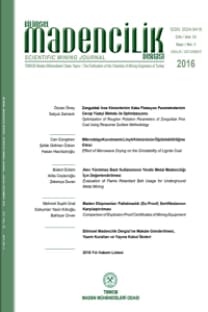SAYISAL MODELLEME YÖNTEMİYLE RMR SİSTEMİNCE ÖNERİLEN TAHKİMAT SİSTEMLERİNİN ANALİZİ
RMR sınıflama sistemi yeraltı açıklıklarının tahkimat tasarımında yaygınlıkla kullanılmaktadır. Sistem aynı kalite kaya kütlesinde farklı derinliklerde oluşturulacak açıklıklar için herhangi bir fark gözetmeksizin aynı tahkimat sistemi önerisinde bulunmaktadır. Bu çalışmanın amacı varsayılan farklı gerilme koşulları altında aynı kalitede kaya kütlesi için RMR sistemince önerilen tahkimat sistemlerinin performanslarının sayısal modelleme tekniği kullanılarak değerlendirilmesidir.Literatürde yer alan farklı araştırmacılar tarafından yapılmış olan proje sonuçları incelenerek orta ve zayıf kalitede kaya kütlesi örnekleri saha verisi olarak seçilmiştir. Derlenen bilgiler kullanılarak örneklerin sayısal modelleri oluşturulmuş ve araştırmacıların elde ettiklerine benzer sonuçlar elde edilmiştir. Sonraki aşamada farklı derinlik değerleri varsayılarak gerilme koşulları değiştirilmiştir. Sayısal olarak modellenen açıklıklara RMR sistemince önerilen tahkimat sistemleri iç basınç cinsinden uygulanmış ve varsayılan farklı gerilme koşullarında açıklıklar etrafındaki gözlemlenen deformasyonlar kaydedilmiştir. Yaygınlıkla kullanılan limit birim deformasyon değerlerinden biri performans ölçütü olarak kullanılmış ve önerilen tahkimat sistemlerinin performanslarına ilişkin değerlendirmeler yapılmıştır
Anahtar Kelimeler:
RMR sistemi, görgül tasarım, sayısal modelleme, tahkimat sistemi performans değerlendirimi
THE ANALYSIS OF THE SUPPORT SYSTEMS PROPOSED BY THE RMR SYSTEM USING NUMERICAL MODELING
RMR rock mass classification system is widely used to design support systems for underground openings. For the underground opening excavated in the same quality rock mass at different depths the system proposes same support system. The purpose of this study is to evaluate the performances of the support systems proposed by RMR system for the openings excavated in the same quality rock mass but under different stress conditions.By using current literature and the results of projects conducted by different researchers fair and poor quality rock masses were selected as case studies. Using the collected information the numerical models of selected cases were constructed and similar results with the researchers were obtained. As a next step the in situ stress conditions were simulated by assuming different depths. The pressure of the support system proposed by RMR was applied to modelled openings in terms of internal support pressure and corresponding deformations were recorded. One of the most widely used critical strain values was used as performance criteria for the support systems and the performance of the proposed support systems were evaluated
Keywords:
The RMR system, empirical design, numerical modelling, support system performance evaluation,
- ISSN: 2564-7024
- Yayın Aralığı: Yılda 4 Sayı
- Yayıncı: TMMOB Maden Mühendisleri Odası
Sayıdaki Diğer Makaleler
TÜM VÜCUT TİTREŞİMİNİN OPERATÖR ve SÜRÜCÜLER ÜZERİNDEKİ ETKİLERİ: ÖLÇÜMÜ ve DEĞERLENDİRİLMESİ
Tuğba DOĞAN, Bülent ERDEM, Zekeriya DURAN
SAYISAL MODELLEME YÖNTEMİYLE RMR SİSTEMİNCE ÖNERİLEN TAHKİMAT SİSTEMLERİNİN ANALİZİ
Ertuğrul KARAKAPLAN, Hakan BAŞARIR
PLASTİK GÖVDELİ SÜRTÜNMELİ KAYA SAPLAMALARININ KULLANILABİLİRLİĞİ
TÜM EMEK İŞ SİTESİ BİNALARININ PATLAYICI KULLANILARAK YIKIMI
Ümit ÖZER, Abdulkadir KARADOĞAN, Meriç Can ÖZYURT, Ülkü KALAYCI, Uğur TUTAR, Bahattin DEMİR, Fazlı TOPRAK
